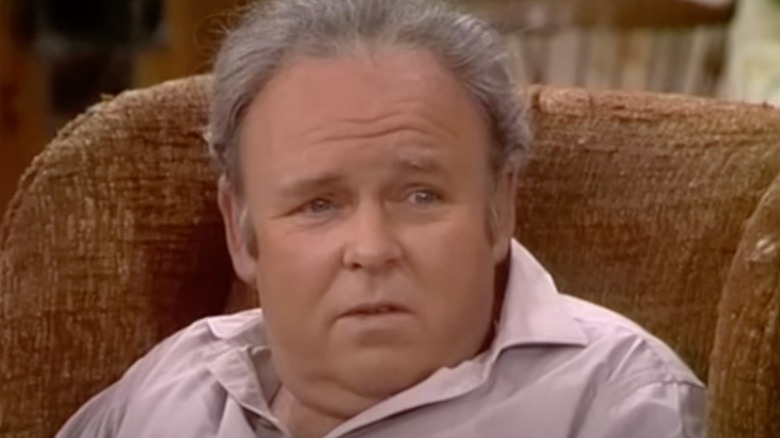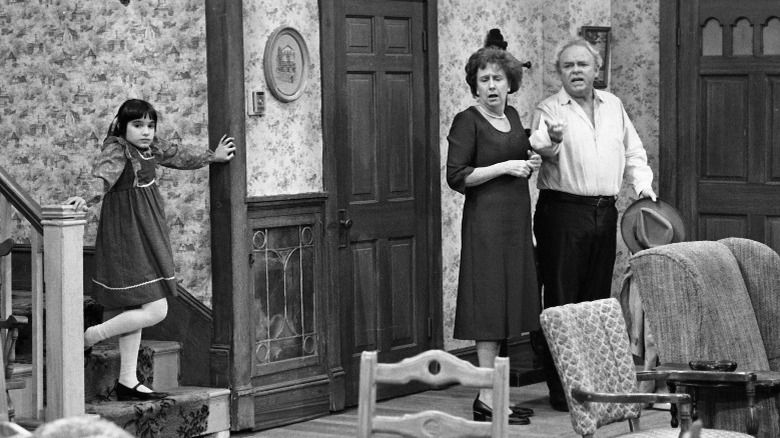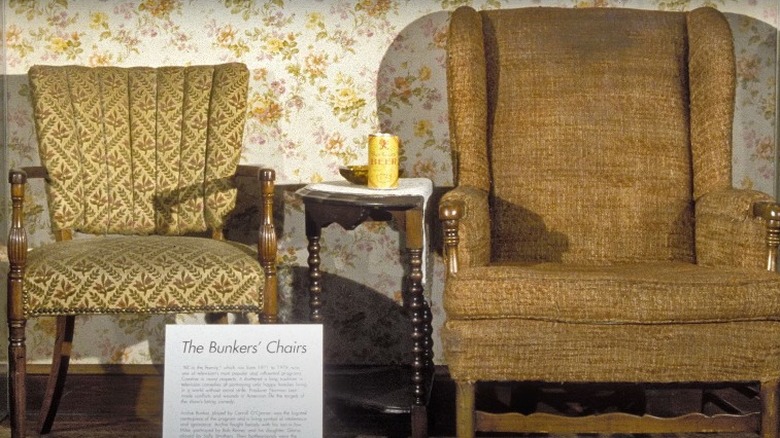You Can Find Archie Bunker's All In The Family Chair In This Museum
When the groundbreaking sitcom "All in the Family" debuted in 1971, America was in turmoil. Civil rights protests, the women's lib movement, and the Vietnam War were galvanizing the younger generation, and Watergate was about to change the face of the presidency. The show addressed the changing times through its iconic characters: Archie Bunker, the outspoken conservative dad from Queens; Edith, his sweet, naïve wife; Gloria, their daughter; and Mike Stivic, their "meathead" liberal son-in-law. The show's humor often stemmed from the clashes between Archie and Mike.
In between laughs, "All in the Family" addressed serious topical issues such as race relations, women's rights, menopause, cancer, the draft, and hate crimes, per IMDb. Archie was laid off from work, Edith was sexually assaulted, and Gloria suffered a miscarriage — not your standard sitcom fare. It also challenged stereotypes. In the episode "Judging Books by Covers," Archie makes homophobic jokes about an ascot-wearing friend of Mike's, only to find out that one of his own best buds, a former NFL player, is gay. If not for the Bunkers, we wouldn't have the Connors of "Roseanne," the Pritchetts of "Modern Family," the Johnsons of "black-ish," or any of the TV families who followed.
"Family" also holds the record for most spinoff shows, Variety notes. Of the seven, the most successful were "The Jeffersons," "Good Times," and "Maude" (starring a pre-"Golden Girls" Bea Arthur!). Another, "Archie Bunker's Place," was a sequel in which Archie became a bar owner.
Archie Bunker's famous chair was donated
Archie Bunker was the self-proclaimed king of 704 Hauser Street. (The address was fictional, but the house shown in the closing credits is a real home in Queens, per the New York Daily News.) The king's throne was a worn brown wing chair in the center of the living room. Anyone who dared park their keister on its sagging tweed seat would be met with an angry demand to "Get outta my chair!"
Aptly enough, Archie's chair — and Edith's smaller companion seat — were $10 thrift-store finds, not designer pieces, according to Smithsonian. The production staff thought they were a perfect fit for a comfortable blue-collar home. As "All in the Family" became a gigantic hit, Americans came to know and love the familiar living room where Archie would spout his un-PC opinions from his favorite chair.
In 1978, when "All in the Family" had wrapped its eighth season, creator Norman Lear donated the chairs to the Smithsonian Institution's National Museum of History and Technology. It was the first time the D.C. museum had ever acquired an entertainment artifact. There was only one problem: Soon afterwards, CBS decided to bring the show back for one more season. Producers had to have new replica chairs made for the set, which cost $15,000. Talk about inflation!
Archie's chair may soon be moving to a new room
Now renamed the National Museum of American History, the Smithsonian building housing the Bunkers' chairs is a must-see for any visitor to Washington, D.C. Here, you can get an up-close view of important historical, political, cultural, and industrial objects. Permanent displays include the First Ladies' gowns, the original Star-Spangled Banner, and the Woolworth's lunch counter where a student sit-in helped spur the civil rights movement.
In December 2022, the museum will debut a new exhibition called "Entertainment Nation." It will showcase artifacts from movies, theater, TV, music and sports, as well as interactive exhibits and an online element. "Through the objects and their stories, the exhibition will explore how, for over 150 years, entertainment has provided a forum for important national conversations about who we are, and who we want to be," the museum's press release explains. Among the items featured will be Prince's Yellow Cloud guitar, Mia Hamm's soccer jersey, Indiana Jones's fedora, the original Kermit the Frog puppet, the ruby slippers from "The Wizard of Oz," and a costume worn by Lin-Manuel Miranda in Broadway's "Hamilton."
The Smithsonian says that the exhibit will be "ever-changing" over the next 20 years, so it's likely that the Bunkers' chairs will be included at least part of the time. Archie probably wouldn't object to having his favorite chair moved to a different room — as long as Meathead doesn't sit in it!


